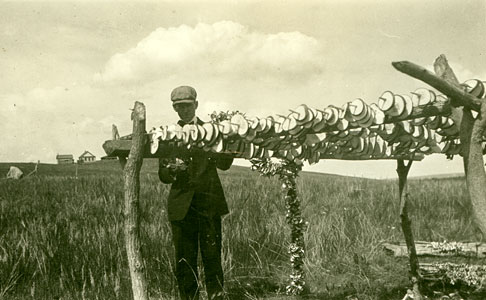
Wolf Chief family stringing squash SHSND# 0086-323Military presence and settlement by European Americans brought a new era to the Mandan, Hidatsa, Arikara and other Native Americans of the Great Plains. Their lives and cultures were confined by reservations. The three tribes were assigned to a reservation in 1870; the reservation was reduced to nearly one-quarter of its original size in 1880. (Hidatsa, p. 74)
During the early reservation period, federal agents attempted to teach Hidatsa, Mandan, and Arikara men to farm. Women continued to engage in small scale farming (or large scale gardening). Women raised traditional foods on the family plots and began to add some new vegetables. Federal Indian agents introduced potatoes and turnips (the mainstay vegetables of pioneer households). Indian families did not like potatoes and turnips and refused to harvest them unless the agent purchased the crop. The federal agents also introduced cash in exchange for food supplies. Women’s ownership of the small food crops gave them independent income; men’s income from the field crops was kept by the agent in trust for the men who did the farming and distributed by the agent as he saw fit. (Hidatsa, p. 70)




